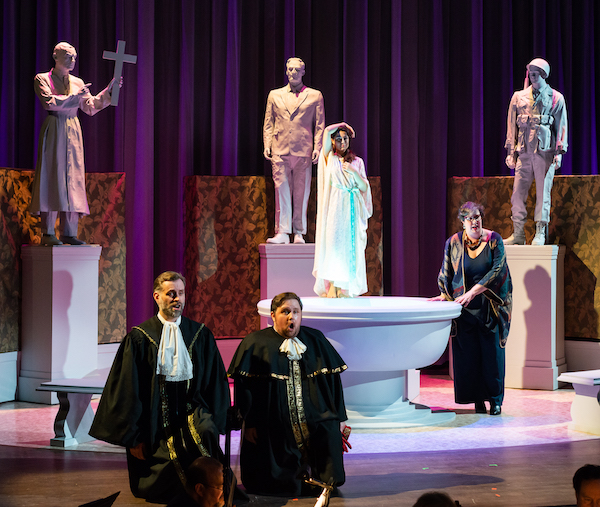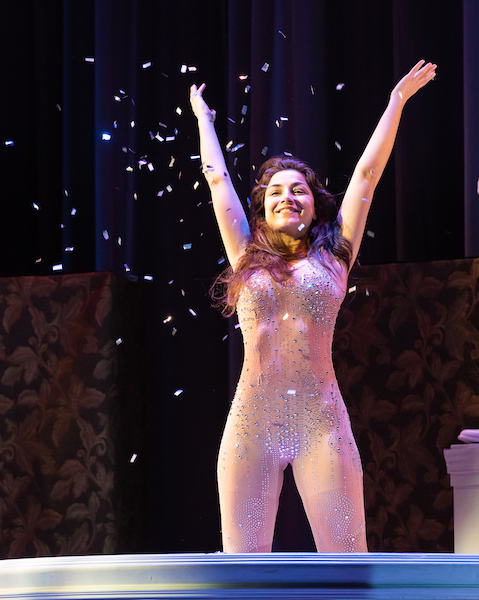Feminist updating of Stradella’s “Susanna” lends contemporary resonance

Opera Lafayette and Heartbeat Opera presented Stradella’s “La Susanna” Monday night at the Kennedy Center. Photo: Louis Forget
Opera Lafayette is closing its season with one of the strongest productions it has ever mounted.
The company’s staging of Alessandro Stradella’s oratorio La Susanna is a memorable collaboration with Heartbeat Opera, a thoughtful, innovative little company based in New York. The second and final performance, heard Monday evening in the Kennedy Center Terrace Theater, was a marvel both musically and dramatically.
The story is from an episode in the childhood of the prophet Daniel, included in that book of the Bible but later discarded by some editors as apocryphal. Two older judges, models of rectitude on the outside but consumed by lust on the inside, spy on a young wife as she bathes in a stream. They try to coerce her to have sex with them, threatening to give testimony that they saw her meeting a lover in the stream. Who would ever accuse such powerful men of lying?
Stradella composed the opera in 1681, the year before he was mysteriously murdered in the streets of Genoa. (Stories about Stradella’s seduction of women leading to his death are historical legend, according to scholar Carolyn Gianturco.) Although most of the story is told by a narrator, the Testo, there are operatic vignettes throughout, which the staging by Heartbeat Opera’s co-artistic director Ethan Heard uses to its advantage.
The conceit is that the performance is an academic lecture, with the Testo presented as a professor of art history and gender studies. Created for a castrato, the role is given to the extraordinary contralto Sara Couden, who displayed a brazen chest voice and buttery legato phrasing in the role, as well as impressive vocal agility. Although Stradella created the work for an all-male cast, this casting change created a new feminist approach to the work.
Soprano Lucía Martín Cartón was a delight in the title role, singing with a translucent tone in Susanna’s first aria, “Quanto invidio il vostro stato,” accompanied simply by theorbo and single cello on hypnotic ground bass pattern. She bathed innocently in a fountain, covered in a sparkling bodysuit, splashing silvery pieces of paper like water (costume design by Beth Goldenberg).
Martín Cartón ably negotiated the faster running part of “Zeffireti che spiegate,” with faultless intonation and ease of dynamic control and breath support. She was no less striking in the prison scene, now in an orange jumpsuit in the second part, coaxing plangent melodic lines from the ciaconna “Da chi spero aita, o Cieli?”

Lucía Martín Cartón performed the title role in Stradella’s “La Susanna.” Photo: Louis Forget
Bass-baritone Paul Max Tipton and tenor Patrick Kilbride were aptly smarmy and repellent as the two judges. Hearn’s direction was stylized, freezing them in exaggerated gestures between movements, often seeming to imitate famous paintings of the subject by Artemisia Gentileschi and many others, like slides for the art history lecture. Although both singers were strong, Tipton seemed to lose the pulse at times, as toward the end of his aria “Voglio amare e che sara.”
The weak link in the cast was soprano Ariana Douglas, featured as the Testo’s graduate student assistant in the first part. In the second part, she yelled “Stop!” during the trial and then took the part of the boy prophet Daniel, who demands a fair trial for Susanna, leading to the happy conclusion. Douglas was dramatically effective, but her intonation was often wayward.
The musical accompaniment was kept simple, with Ryan Brown and Jacob Ashworth, music directors of Opera Lafayette and Cantata Profana, respectively, playing the score’s two treble parts on dueling violins. The continuo part was shared in inventive combinations among harpsichord, theorbo, cello, and bass. Stradella’s score is notated essentially in trio sonata format, so this version made sense, although one occasionally missed the use of recorders or other paired instruments on the top parts heard on some recordings.
Heard’s program note made explicit connections between his staging and recent events, like Brett Kavanaugh’s Supreme Court nomination hearings. Fortunately, the production was less heavy-handed than his explication, featuring large statues of a priest with a cross, a suited businessman, and a helmeted soldier (scenic design by Reid Thompson).
Heard pulled no punches in the bathing scene, as the two judges groped and leered at Susanna, or in the trial, where bright strobe lights glared harshly on the voiceless Susanna. It was that rare occasion where artistic past and political present mingled in a way both uncomfortable and thought-provoking.
La Susanna runs from May 2 to May 5 at BAM Fisher in New York. operalafayette.org; 212-634-9388
